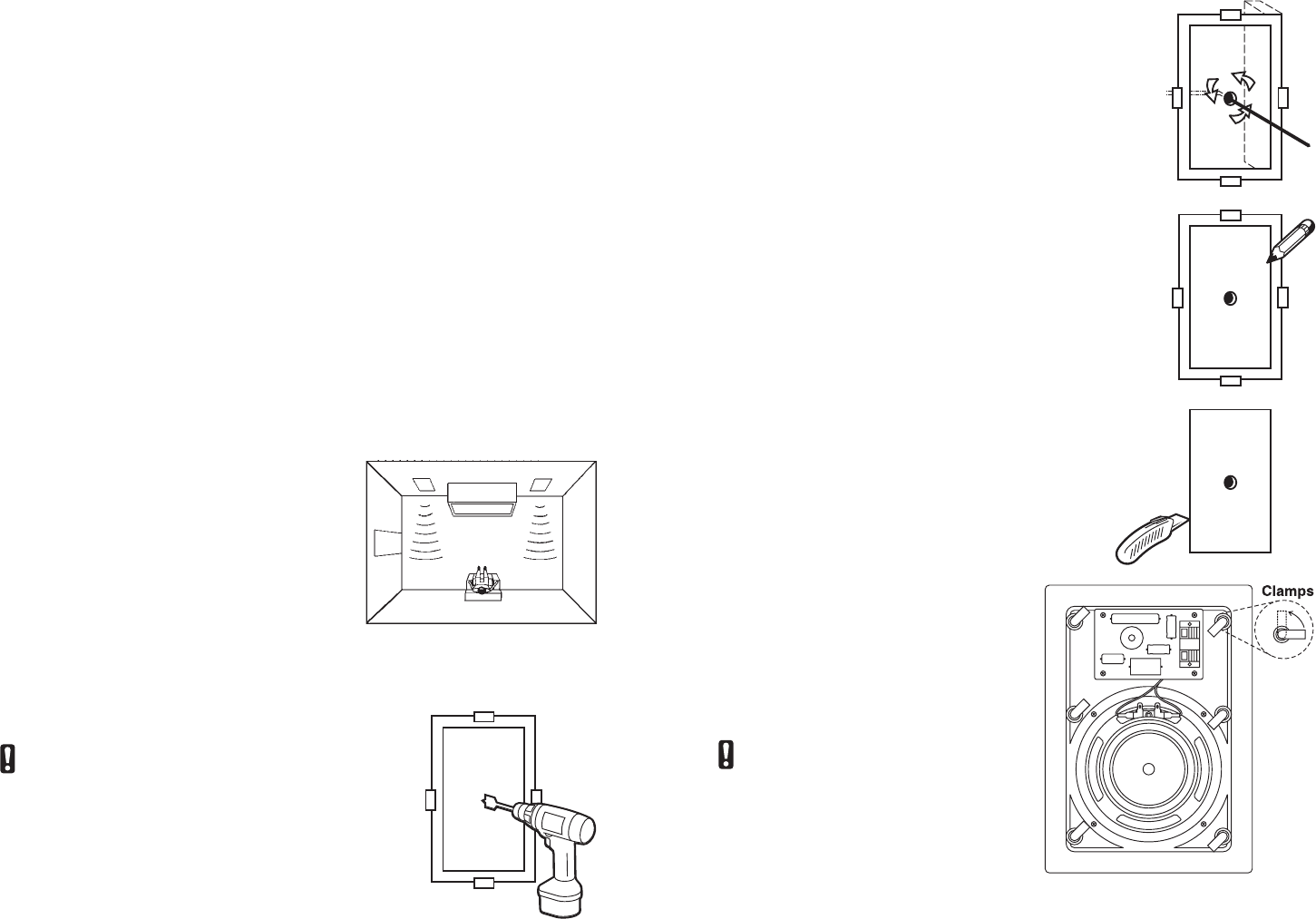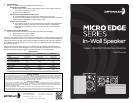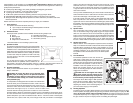
Congratulations on the purchase of your Dayton Audio
®
Micro-Edge™ Series In-Wall Speakers.
These speakers were manufactured with high quality components and engineered to deliver top
quality sound performance.
● Contemporary Micro-Edge
TM
low profile grill design with magnetic grill retention
● Long-throw woven Kevlar
®
woofer with rubber surround
● 1" pivoting silk dome tweeter for targeted sonic detail
● 12 dB/octave optimized crossover featuring exclusive tuning by Dayton Audio
● Selectable 0dB/-3dB/-6dB tweeter attenuation switch for effortless room integration
● All Dayton Audio Micro-Edge Series speakers are timbre matched to provide the best home
theater experience.
Please read these instructions completely before you begin your installation.
1) Parts Inventory
Your speaker kit should include the following:
● 1 pair of Dayton Audio Micro-Edge In-Wall Speakers with Grills
● 1 speaker installation template
2) Installation Tools
The Dayton Audio speakers can be installed with the following simple tools:
● Pencil ● #2 Phillips screwdriver
● Masking tape ● Wire cutters & wire stripper/crimp tool
● Drill & drill bits ● Stud finder (optional)
● Utility knife or wallboard saw*
* Recommended for use if installing in plaster walls.
3) Speaker Location
To achieve the best performance from your Dayton Audio
speakers, it is important to carefully select the location for
installation. Your in-wall speakers should be installed 5 to
8 feet apart to ensure proper stereo imaging. Mount each
speaker the same distance from the ceiling to maintain
a uniform look. Keep the speakers at least 2 feet away
from the corners of the room to avoid overemphasized
bass reproduction.
For the best stereo imaging, the listening position is
centered between the speakers with the tweeters at ear
level. Decide if the primary listening position will be in a seated or standing position. Mount the
speakers so the tweeters are at the same level or slightly above the listener’s ears.
4) Speaker Installation
Once you have selected the location for your speakers, you are
ready to install them.
CAUTION: Be certain that there are no electrical wires,
water pipes, or heating ducts in the planned installation
area before you start drilling or cutting into the wall. If there
is an electrical outlet nearby, turn off the circuit breaker to
avoid possible injury.
In-wall speakers are designed to be mounted in the wall between
the studs. Once you have selected the location, check to be sure
you are between the studs. One method is to tap on the wall; you
will hear a hollow sound when between two studs and a sharper, more
solid sound when right on top of, or close to a stud. An easier, more
accurate method for finding the location of studs is to use a stud finder.
The Micro Edge™ Series in-wall speakers include a punch-out template for marking the cutout.
To locate and mark the cutout for the speakers, remove the center punch-out and tape the
speaker template to your wall in the desired location. Drill a 1" hole in the center of the template
outline. Next, use a piece of stiff wire (a coat hanger works well), and bend it at a 90-degree
angle, 8" from the end. Insert the bent part of the wire into the 1" hole
and rotate the wire in a complete circle to check for obstructions. If
the wire hits a stud on either side, reposition your template to the left
or right and drill a new hole at the center, then repeat the test until a
clear area is located.
Once you have established that your chosen location is between two
studs, and that there are no obstructions in the wall, scribe a clear line
around the inside edge of the template with a pencil.
If the wall is made of drywall, simply cut the marked area with a utility
knife or drywall saw. If the wall is made of plaster, use a saw with a
higher tooth count to reduce the chance of breaking the plaster. Test fit
the speaker in the hole, the speaker should fit loosely and the speaker
frame should cover the edges of the hole. Repeat these steps for the
other speaker.
5) Speaker Cable
Don’t compromise sound quality by using thin, inexpensive speaker
wire, we recommend using a high quality oxygen free copper speaker
cable. For runs less than 50 feet we recommend 16 gauge cable; for
longer runs we recommend 14 gauge or larger cable. Most municipalities
require the use of CL2 rated speaker cable for installation in walls and
ceilings. Leave enough speaker cable so you can stand comfortably on
the floor or ladder while connecting the speaker cable to the speakers.
6) Speaker Connection
Remove about 8" of the cable jacket to expose the inner conductors.
Strip 1/4" of insulation from each conductor and connect to the speaker
terminals. When connecting the wires to the speakers, be sure to
observe proper polarity. Most CL2 rated speaker cable will have red
and black conductors, so you will connect the red wire to the
red speaker terminal and the black wire to the black speaker
terminal.
7) Final Installation
To install the speakers into the wall, remove the
grills using a small paper clip, this will give you
access to the mounting screws. Turn the mounting
clamps so they are positioned as in the illustration,
this will allow the speakers to clear the hole for
installation. Insert the speaker into the hole, and
tighten the mounting screws. As you turn each
screw, the mounting clamps will rotate outward to
engage the wall material.
CAUTION: Do not over-tighten the clamps.
Too much torque may snap off the lug and
the speaker will not seat securely. A snug fit is all
that is necessary to assure proper performance.
The Dayton Audio Micro-Edge In-Wall speakers
feature pivoting tweeters. Adjust the tweeters so
they point in toward the listening area. Properly
adjusting the direction of the tweeters greatly im-
prove the stereo imaging of the speakers.
8) Painting Speakers
To paint the grill of your Micro-Edge speakers, remove the grill assembly (with plastic trim edge)
from the speaker, and apply paint to the grill using an airbrush, airless sprayer, or spray can. Do
not try to paint the chassis and grill assembly together, the grill should always be removed
and painted separately. Do not apply heavy coats of paint that might block the perforations in
the grill, and allow the paint to fully dry before re-installing the painted grill.




